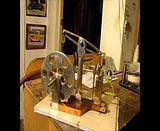deere_x475guy
Well-Known Member
Ariz, nice job on the build, congratulations. I do have one guestion. On Brians plans part #14 is the piston rod guide and I didn't see that on your build. Did you do this intentionally? It appeared you had drilled the hole for it but never used it. I was thinking about eliminating this part also but questioned if it was actually needed. Looks like yours if running great without it.





